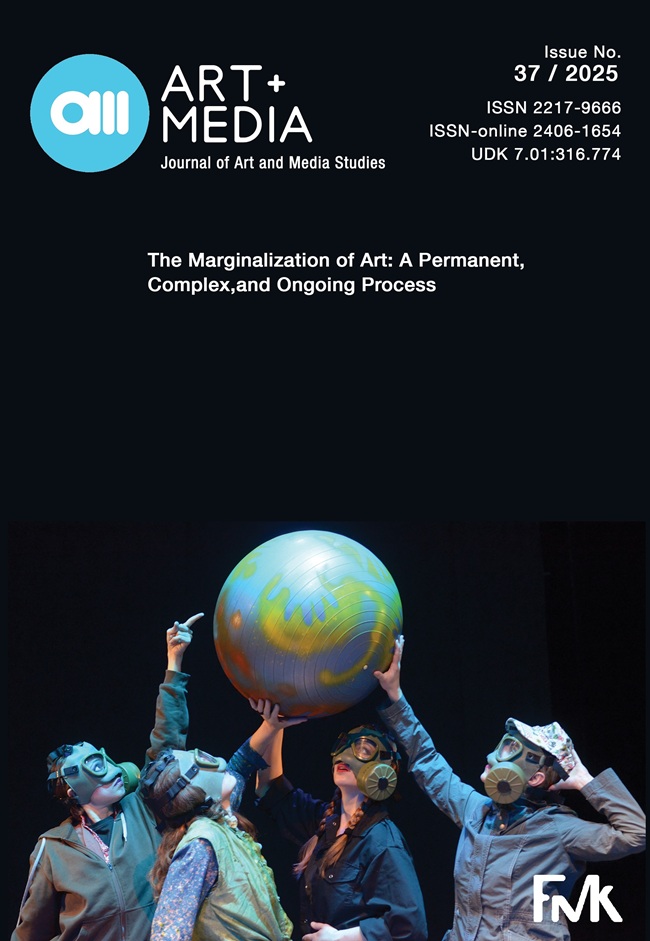How Else Can We Think About Art? Aesthetics, Technosphere, and the Post-Metaphysical Image
DOI:
https://doi.org/10.25038/am.v0i28.624Keywords:
technosphere; figurality; aisthesis; visualization; art; aesthetics; posthumanism; digital aesthetics.Abstract
In this article, the author asserts that the technosphere denotes the last frontier of metaphysical thought within which both aesthetics, as a philosophical discipline, and the aesthetic replaced by the concepts of aisthesis, figurality and visualization, after the end of all conceptual-categorical systems of thought about the essence of art from Immanuel Kant to Friedrich Hegel and Friedrich Schelling to Theodor Adorno, still appear as relics of language and its ontological structure of telling “about” the world. Aesthetics emerged in the era of the rise of rationalism and modern technology. Aisthesis, figurality and visualization are conceptual tools for what connects the thought of the technosphere and its world-forming “aesthetic objects”. The central problem of this article is to articulate post-aesthetic thinking. The conceptual tools are figurality, aisthesis, visualization, and the main thesis attempts to demonstrate that art in the technosphere, as autopoietic semiosis, becomes an assemblage of new categories and concepts that transcend all metaphysical matrices.
References
Bense, Max. Estetika. Translated from German by Radoslav Putar. O. Keršovani, 1971.
Broadhurst, Susan. Digital Practices: Aesthetic and Neuroaesthetic Approaches to Performance and Technology. Palgrave Macmillan, 2007.
Deleuze, Gilles, and Felix Guattari. Qu’est-ce que la philosophie? Les Éditions de Minuit, 1991.
Deleuze, Gilles. Cinema 1: The Movement-Image. University of Minnesota Press, 1986. DOI: https://doi.org/10.5040/9781350251977
Deleuze, Gilles. Cinema 2: The Time-Image. University of Minnesota Press, 1989.
Deleuze, Gilles. Francis Bacon: The Logic of Sensation. University of Minnesota Press, 2005.
Eco, Umberto. Estetički problem u Tome Akvinskoga. Translated from the Italian by Sanja Roić. Globus, 2005.
Flusser, Vilém. Kommunikologie. S. Fischer, 1998.
Gadamer, Hans-Georg. Ogledi o filozofiji umjetnosti. Translated from the German by Darija Domić. AGM, 2003.
Godard, Jean-Luc. Histoire(s) du cinéma. Gallimard, 1998.
Heidegger, Martin “Die Zeit des Weltbildes.” In Holzwege, 75-113. Klostermann, 2003, 8th unchanged edition. DOI: https://doi.org/10.5771/9783465142362-75
Heidegger, Martin. “Die Frage nach der Technik.” In Vorträge und Aufsätze, 9-40. Klett-Cotta, 2009, 11th edition.
Kittler, Friedrich W. “Schrift and Zahl: Die Geschichte des errechneten Bildes.” In Iconic Turn. Die Neue Macht der Bilder, edited by Hubert Burda and Christa Mahr, 186–203. DuMont Publisher, 2005.
Lyotard, Jean-François. Discours, Figure. Klicksieck, 1971.
Mersch, Dieter. Epistemologien des Ästhetischen. Diaphanes, 2015.
Mersch, Dieter. Ereignis und Aura: Untersuchungen zu einer Ästhetik des Performativen. Suhrkamp, 2002.
Paić, Žarko. “The Brain as a Vision and Program: From ‘Embodiment’ to ‘Embedment’.” In Brain, Decision Making, and Mental Health, edited by Nima Rezai, 575–93. Springer, 2023. DOI: https://doi.org/10.1007/978-3-031-15959-6_27
Paić, Žarko. Aesthetics and the Iconoclasm of Contemporary Art: Pictures Without a World. Springer, 2021. DOI: https://doi.org/10.1007/978-3-030-75305-4
Paić, Žarko. Art and the Technosphere: The Platforms of Strings. Cambridge Scholars Publishing, 2022.
Paić, Žarko. Izgledi nadolazeće filozofije: Metafizika-kibernetika-transhumanizam. Mizantrop, 2023.
Paić, Žarko. The Superfluity of the Human: Reflections on the Posthuman Condition. Schwabe Verlag, 2023. DOI: https://doi.org/10.24894/978-3-7965-4838-3
Penrose, Roger. The Road to Reality: A Complete Guide to the Laws of the Universe. Vintage, 2007.
Purgar, Krešimir. Pictorial Appearing – Image Theory After Representation. Transcript, 2019. DOI: https://doi.org/10.1515/9783839441350
Reichle, Ingeborg. Art in the Age of Technoscience: Genetic Engineering, Robotics, and Artificial Life in Contemporary Art. Springer, 2009. DOI: https://doi.org/10.1007/978-3-211-78161-6
Sachs-Hombach, Klaus. Bildwissenschaft zwischen Reflexion und Anwendung. Herbert von Halem Verlag, 2005.
Schiller, Friedrich. Über die Ästhetische Erziehung des Menschen in einer Reihe von Briefen. W. de Gruyter, 2019.
Sloterdijk, Peter. Der Denker auf der Bühne: Nietzsches Materialismus. Suhrkamp, 1986.
Welsch, Wolfgang. Äesthetisches Denken. Reclam, 1993.
Wittgenstein, Ludwig. Philosophical Investigations. Wiley-Blackwell, 1953.
Downloads
Published
How to Cite
Issue
Section
License
Copyright (c) 2025 AM Journal of Art and Media Studies

This work is licensed under a Creative Commons Attribution-NonCommercial-NoDerivatives 4.0 International License.
The content on this site is licensed under a Creative Commons Attribution 4.0 International License.
AM Journal of Art and Media Studies ISSN 2217-9666 - printed, ISSN 2406-1654 - online, UDK 7.01:316.774
Contact: amjournal@outlook.com
Publisher: Faculty of Media and Communications, Singidunum University, Belgrade, Serbia
Indexed in: ERIH PLUS, EBSCO, DOAJ, and in The List of Scientific Journals Categorization of Ministry of Education, Science and Technological Development of Republic of Serbia (M24 in 2021; M23 in 2023). Beginning with No. 12 2017, AM is indexed, abstracted and covered in Clarivate Analytics service ESCI.

